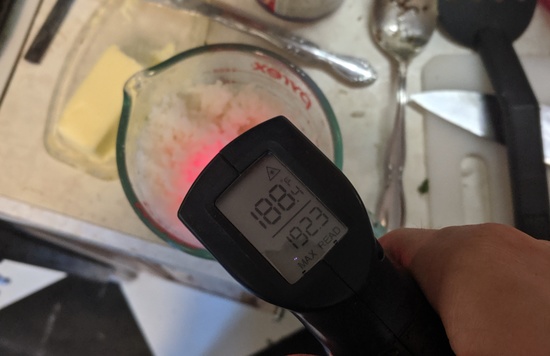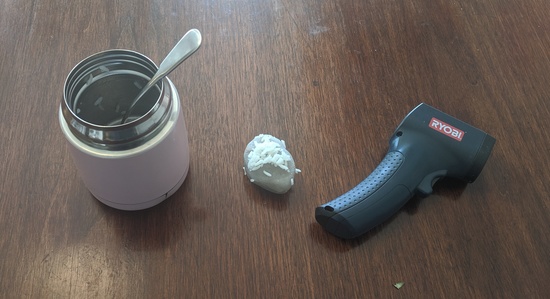A thermos does a great job with liquids: the insulation means you can
pour in hot soup in the morning, and enjoy hot soup at lunch. But it
doesn't do nearly as good a job with solids: fill one with rice and it
quickly falls into the "danger zone".
One recommendation you'll see is that you should fill the thermos with hot water, let it sit, and then swap the water for the food. This does help, but because the thermos doesn't have that much thermal mass it only helps some. What if we put a rock in the thermos to hold heat, and preheat it along with the rest of the thermos? How much does this help? Does this help enough?
The general rule is that hot food shouldn't be below 140F for more than two hours, because substantial bacteria can grow, and the closer it is to 100F the worse it is. My goal here is to be able to send hot dry food with Lily's lunch, and I pack it four hours before she gets to eat it, so the question is: what's the temperature two hours in, which is two hours before lunch time? If that's above 140F we're ok, if not we should figure something else out.
I ran an experiment on one cup of cooked rice, the kind of dry food you're not normally supposed to put in a thermos. I heated it in the microwave until it was steaming hot (it measured ~188F with an infrared thermometer):
I tested this in three configurations:
T1: a thermos that has been pre-heated with boiling water.
T2: same as T1, but with the addition of a 4.3oz (122g) rock with volume 1.5oz (45ml).
T3: same as T2, but the thermos has been preheated with two rounds of boiling water.
- T1: 108F
- T2: 136F (143F in the middle)
- T3: 142F (148F in the middle)
This works, but it is kind of hacky: rocks are odd shaped, hard to clean, rattle around, hide food, etc. How else could we solve this? Ideas:
Use water instead of a rock, because water has excellent heat capacity by volume and very good heat capacity by weight. Have two sections: an outer one you pour boiling water into, and an inner one for the dry food. Keep heat from leaving the overall enclosure, but allow heat to move freely between the two sections.
Something microwave-safe which uses a solid for the thermal mass. tick it in the microwave for a few minutes before putting the food in, or even with the food inside. Water has a maximum temperature of ~212F, but with a design like this you could bring your thermal mass up to, say, 300F (wrapped in an insulating layer so no one got burnt).
Use a phase-change material? Maybe like this travel mug but with a higher target temperature than 136F.
Battery powered cross between a thermos and a crock pot. I do see some things kind of like this aimed at people who want to keep coffee warm in their car (no battery; takes power from the car) and some expensive ones (ex) that have good internal batteries. But nothing I can find designed to eat warm dry food out of?

